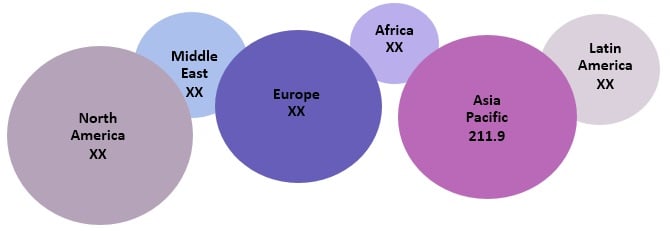Wound Care Biologics Market – Experience the Power of Effective Healing
Wound care biologics are bioengineered products used for non-healing wounds of the lower extremity. Demand for wound care biologic products is expected to increase significantly as early intervention of diabetic ulcer can prevent severe complications such as infection, hospitalization, and amputation. Wound care biologics market is expected to gain significant traction, as the commercially available skin substitutes have clinical and experimental evidence of efficacy in wound healing.
The global wound care biologics market was valued at US$ 1.2 billion in 2016 and is expected to exhibit a robust CAGR of 6.9% over the forecast period (2017–2025).
Figure 1. Global Wound Care Biologics Market Value (US$ Mn), by Region, 2016

To learn more about this report, Download Free Sample
Source: Coherent Market Insights (2018)
High prevalence of diabetes is expected to aid in growth of the market
The wound care biologics market is expected to gain significant traction, with rise in global prevalence of diabetes, as diabetic patients are prone to developing diabetic ulcers. According to the Global Diabetes Community, 2017, an estimated 422 million adults are living with diabetes globally, and this is expected to increase to 642 million by 2040. Also, according to the Journal of Foot and Ankle Surgery, 2016, increasing number of diabetic patients has led to increased burden of diabetic complications, where peripheral neuropathy, foot ulceration, and Peripheral Arterial Disease (PAD) is twice as common for diabetic patients as compared to non-diabetics, affecting 30% of the diabetics aged 40 years and above. The Advances in Wound Care Journal, 2015, also stated that 15%–20% of the diabetic population is likely to develop chronic, non-healing foot wounds. Thus, wound care biologic products provides patients with a cost effective option for managing chronic wounds, thereby reducing economic burden of the patients.
However, high cost of skin substitutes and related biologics is a major hindrance for growth of the market. For instance, according to the Advances in Skin Substitutes Journal, 2014, cost for each 1% body surface area covered with Epicel, is estimated to be over US$ 13,000. This in turn, leads to increasing adoption of alternative and cost effective wound care products, which is expected to negatively affect growth of the market.
Asia Pacific market to exhibit fastest growth over the forecast period
Asia Pacific is expected to exhibit significant growth in the global wound care biologics market over the forecast period. This is owing to high prevalence of diabetic patients in Asian countries. According to the Indian Diabetes Research Foundation, 2016, around 60% of the world’s population suffering from diabetes lives in Asia, with around one-half in China and India combined. The Foundation also states that Western Pacific reported over 138.2 million people suffering from diabetes, the number for which is expected to rise to 201.8 million by 2035.
Moreover, rising medical tourism in Asia Pacific is a major driver for growth of the market. The number of foreign patients is increasing, owing to affordable treatment facilitates at hospitals for wound care management. According to the survey by Brink Global Risk Center, 2017, around 4 million medical tourists traveled to India for health care services, 3.5 million foreign patients travelled to Thailand and 900,000 patients to Singapore in 2016, with the number expected to grow by 10%–14% by 2020.
Increasing incidence of chronic wounds and ulcers to accelerate the market growth
Chronic wounds have a significant impact on the health and quality of life of patients and their families, causing pain, emotional stress, restriction on daily activities, depression, distress, and anxiety, with prolonged hospital stay and chronic morbidity. According to the Advances in Wound Care Journal, 2015, chronic leg and foot ulcers last for around 12 months on an average, with recurrence affecting up to 65% of patients, leading to loss of function and decreased quality of life. It is also a significant cause of morbidity. Rising incidence of traumatic events such as accidents and fire accidents causing burns, systemic illness, antibiotic resistant, chronic disease, surgery, and impaired mobility are the prevailing factors resulting in increasing incidence of chronic wounds. The World Health Organization (WHO) also states that burns are the leading cause of morbidity, including prolonged hospitalization, disfigurement, and disability-adjusted life-years (DALYs) lost in low- and middle-income countries. Therefore, these factors are expected to be major factor aiding ion growth of the market over the forecast period.
North America is expected to be dominant region in the wound care biologics market, owing to rising prevalence of chronic non-healing wounds which pose an economic burden to the healthcare system. According to the American Diabetes Association, 2016, the average cost of healing a single foot ulcer is US$ 8,000 and that of a major amputation is $45,000. Furthermore, venous leg ulcers are the most common wound type in the U.S., affecting almost 2 million people.
Major players operating in the global wound care biologics market are Smith & Nephew Plc., Organogenesis, Inc., Integra Lifesciences Holdings Corporation, Skye Biologics, Alphatec Holdings, Inc., Solsys Medical LLC, Amino Technology LLC, and Osiris Therapeutics, Inc.
Share
Share
Missing comfort of reading report in your local language? Find your preferred language :
Transform your Strategy with Exclusive Trending Reports :
Frequently Asked Questions
Select a License Type
Joining thousands of companies around the world committed to making the Excellent Business Solutions.
View All Our Clients